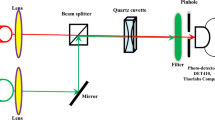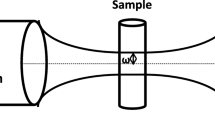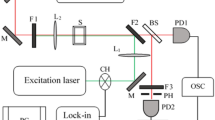Abstract
In this experimental work, the thermal parameters of polymethyl methacrylate/chloroform solution at different concentrations were investigated using laser mode-mismatched thermal lens spectroscopy. For this purpose, first, the thermal lensing parameters of chloroform, propanone and carbon tetrachloride were measured. The measured values were in agreement with the reference values. The maximum deviation of measured values from reference date for these materials was obtained 1.8%, 1.9% and 1.9%, respectively. Then, the thermal lens process for concentrations of 0.1, 0.15, 0.2, 0.25, 0.3, 0.35, 0.4, 0.45, 0.5, 0.55, 0.6, 0.65, 0.7 and 0.75 \(\frac{{\text{g}}}{{{\text{mL}}}}\) polymethyl methacrylate was studied. The results showed that with decreasing concentration, both the creation and relaxation of the thermal lens process occur more rapidly. In addition, for each of these w/v ratios, the thermal diffusivity was measured. It was found that for this polymer, increasing the concentration leads to a decrease in thermal diffusivity. For changes in the concentration of 0.1–0.75 \(\frac{{\text{g}}}{{{\text{mL}}}}\), the thermal diffusivity of polymethyl methacrylate/chloroform solution changes in the range of 0.75–0.26 \(\frac{{{\text{m}}^{2} }}{{\text{s}}}\). In fact, an increase in the concentration of polymethyl methacrylate leads to enhanced scattering of thermal waves, and as a result, the thermal diffusivity is reduced.





Similar content being viewed by others
References
A. Ladaru, H. Moisa, A.V. Ciurea, Biomatrials used in cranioplasty new aspects and perspectives. Proc. Rom. Acad. Series B 21(2), 111–119 (2019)
U. Ali, K.J.B.A. Karim, N.A. Buang, A review of the properties and applications of poly (Methyl Methacrylate) (PMMA). Polym. Rev. 55(4), 678–705 (2015)
K. Myer, Handbook of Materials Selection (Wiley, Hoboken, 2002)
A.C. Henry, T.J. Tutt, M. Galloway, Y.Y. Davidson, C.S. McWhorter, S.A. Soper, R.L. McCarley, Surface modification of poly(methyl methacrylate) used in the fabrication of microanalytical devices. Anal. Chem. 72(21), 5331–5337 (2000)
B. Adhikari, S. Majumdar, Polymers in sensor applications. Prog. Polym. Sci. 29(7), 699–766 (2004)
J.J. Shah, J. Geist, L.E. Locascio, M. Gaitan, M.V. Rao, W.N. Vreeland, Surface modification of poly(methyl methacrylate) for improved adsorption of wall coating polymers for microchip electrophoresis. Electrophoresis 27(19), 3788–3796 (2006)
L.H. Lee, W.C. Chen, High-refractive-index thin films prepared from trialkoxysilane-capped poly (methyl methacrylate). Titania Mater. Chem. Mater. 15, 1137–1142 (2001)
N. Kanth, W. Xu, U. Prasad, D. Ravichandran, A.M. Kannan, K. Song, PMMA-TiO2 fibers for the photocatalytic degradation of water pollutants. Nanomaterials 10(7), 1279 (2020)
S. Gao, C. Baker, L. Chen, X. Bao, Fabrication of chirped fiber Bragg gratings in a non-uniform single-core As2Se3-PMMA tapered fiber. J. Lightwave Technol. 38(15), 3822–3832 (2020)
A.A. Raffi, M.A. Rahman, M.A.M. Salim, N.J. Ismail, M.H.D. Othman, A.F. Ismail, H. Bakhtiar, Surface treatment on polymeric polymethyl methacrylate (PMMA) core via dip-coating photopolymerisation curing method. Opt. Fiber Technol. 57, 102215 (2020)
P. Miluski, M. Kochanowicz, J. Żmojda, A. Baranowska, T. Ragiń, D. Dorosz, White light emission PMMA fibre co-doped with 1,4-Bis (2-methylstyryl) benzene and Rhodamine B for new optical applications. Ceram. Int. 46(16), 26260–26263 (2020)
J. Kost, R. Langer, Responsive polymeric delivery systems. Adv. Drug Deliv. Rev. 64, 327–341 (2012)
M. Shi, J.D. Kretlow, P.P. Spicer, Y. Tabata, N. Demian, M.E. Wong, F.K. Kasper, A.G. Mikos, Antibiotic-releasing porous polymethylmethacrylate/gelatin/antibiotic constructs for craniofacial tissue engineering. J. Control. Release 152(1), 196–205 (2011)
S. Mishra, G. Sen, Microwave initiated synthesis of polymethylmethacrylate grafted guar (GG-g-PMMA), characterizations and applications. Int. J. Biol. Macromol. 48(4), 688–694 (2011)
A. Leal-Junior, A. Frizera, C. Marques, M.J. Pontes, Mechanical properties characterization of polymethyl methacrylate polymer optical fibers after thermal and chemical treatments. Opt. Fiber Technol. 43, 106–111 (2018)
R. Shanti, F. Bella, Y.S. Salim, S.Y. Chee, S. Ramesh, K. Ramesh, Mater. Des. 108, 560–569 (2016)
S.S. Suresh, S. Mohanty, S.K. Nayak, Preparation and characterization of recycled blends using poly (vinyl chloride) and poly(methyl methacrylate) recovered from waste electrical and electronic equipments. J. Clean. Prod. 149, 863–873 (2017)
M.R. Mohebbifar, The laser power effect on the performance of gas leak detector based on laser photo-acoustic spectroscopy. Sens. Actuators A 305(5), 1–15 (2020)
M.R. Mohebbifar, The signal-to-noise ratio measurement in chloroform detection in the presence of krypton buffer gas by laser photoacoustic method. Belgorod State Univ. Sci. Bull. 51(3), 102–108 (2019)
Y. Ma, Y. He, Y. Tong, Yu. Xin, F.K. Tittel, Quartz-tuning-fork enhanced photothermal spectroscopy for ultra-high sensitive trace gas detection. Opt. Express 26(24), 32103–32110 (2018)
B. Dibaee, P. Parvin, A. Bavali, V. Daneshafrooz, M.R. Mohebbifar, Effect of colliding partners on the performance of SF6 and SO2 trace measurements in photoacoustic spectroscopy. Appl. Opt. 54(30), 8971–8981 (2015)
M.R. Mohebbifar, J. Khalilzadeh, B. Dibaee, P. Parvin, Effect of buffer gases on the performance of SO2 trace measurement based on photoacoustic spectroscopy. Infrared Phys. Technol. 65, 61–66 (2014)
M.R. Mohebbifar, High-sensitivity detection and quantification of CHCl3 vapors in various gas environments based on the photoacoustic spectroscopy. Microw. Opt. Technol. Lett. 10(10), 1–8 (2019)
W.B. Deusa, M. Venturaa, J.R. Silvaa, L.H.C. Andradea, T. Catundab, S.M. Limaa, Monitoring of the ester production by near-near infrared thermal lens spectroscopy. Fuel 253, 1090–1096 (2019)
L. Mingqiang, Influence of thermal conductivity on photothermal lens spectroscopy. Thermochim. Acta 672, 126–132 (2019)
B.A.N. Asbaghi, N. Shokoufi, S.N. Hajibaba, Bovine serum albumin determination based on methylene blue detection by photothermal lens spectroscopy. Anal. Biochem. 594, 113621 (2020)
M.R. Mohebbifar, Investigation of thermal lens performance of rhodamine 6G and rhodamine B at different concentration using pump/probe laser thermal lens spectroscopy. Optik 242(166902), 1–8 (2021)
M.R. Mohebbifar, Experimental comparison of methods based on falling and rising signal regions for thermal diffusivity measurement by pulsed dual-beam thermal lens spectroscopy. Measurement 156, 107611 (2020)
M.R. Mohebbifar, E. Mohammadi-Manesh, Experimental and numerical study of laser energy effect on the thermal lensing behavior of ethyl acetate and ethanol by thermal lens spectroscopy. Optik 228, 166149 (2021)
R.D. Snook, R.D. Lowe, Thermal lens spectrometry. A review. Analyst 120, 2051–2068 (1995)
M.E. Long, R.L. Swofford, A.C. Albrecht, Thermal lens technique: a new method of absorption spectroscopy. Science 191(4223), 183–185 (1976)
Edward D. Palik, Handbook of Optical Constants of Solids, Chapter 3—Thermo-Optic Coefficients, vol V (1997), pp. 115–261
C.V. Bindhu, S.S. Harilal, V.P.N. Nampoori, Thermal diffusivity measurement in organic liquid using transient thermal lens colorimetry. Opt. Eng. 37(10), 2791 (1998)
R. Zamiri, B.Z. Azmi, M. Shahril Husin, G. Zamiri, H.A. Ahangar, Z. Rizwan, Thermal diffusivity measurement of copper nanofluid using pulsed laser thermal lens technique. J. Euro. Opt. Soc. Rap. Public. 7, 12022 (2012)
A.J. Twarowski, D.S. Kliger, Multiphoton spectra using thermal blooming. Chem. Phys. 20, 259–264 (1977)
A.J. Twarowski, D.S. Kliger, Multiphoton absorption spectra using thermal blooming—theory. Chem. Phys. 20, 253–258 (1977)
K. Mori, T. Imasaka, N. Ishibashi, Thermal lens spectrophotometry based on pulsed laser excitation. Anal. Chem. 54(12), 2034–2038 (1982)
S.E. Bialkowski, Photothermal Spectroscopy Methods for Chemical Analysis, Wiley, Hoboken, NJ, (1996) pp. 290
H. Cabrera, A. Marcano, Y. Castellanos, Absorption coefficient of nearly transparent liquids measured using thermal lens spectrometry. Condens. Matter Phys. 9(46), 385–389 (2006)
M. Benitez, A. Marcano, N. Melikechi, Thermal diffusivity measurement using the mode-mismatched photothermal lens method. Opt. Eng. 48(4), 043604 (2009)
K. Raznjevic, Handbook of Thermodynamic Tables and Charts (Hemisphere, Washington, DC, 1976)
R.C. Weast, CRC Handbook of Chemistry and Physics (CRC Press, Boca Raton FL, 1987)
VDI e. V., VDI Heat Atlas (VDI Wärmeatlas), Auflage,VDI-Verlag (Düsseldorf) (Springer, 1988), pp. 21–29
A. Missenard, Conductivite Thermique des Solides, Liquides, Gas et Leure Melanges (Editions Eyrolles, Paris, 1965), pp. 122
S.R. Atalla, A.A. Ei-sharkawy, F.A. Gasser, Measurement of thermal properties of liquids with an AC heated-wire technique. Int. J. Thermophys. 2(2), 155 (1981)
D.R. Lide, CRC Handbook of Chemistry and Physics, 85th edn. vol 85 (2005), pp. 6–214
L. Qun-Fang, L. Rui-Sen, Ni. Dan-Yan, H. Yu-Chun, Thermal conductivities of some organic solvents and their binary mixtures. J. Chem. Eng. Data 42, 971–974 (1997)
M. Fujii, X. Zhang, N. Imaishi, S. Fujiwara, T. Sakamoto, Simultaneous measurements of thermal conductivity and thermal diffusivity of liquids under microgravity conditions. Int. J. Thermophys. 18(2), 327–339 (1997)
C. Baroncini, G. Latini, P. Pierpaoli, Thermal conductivity of organic liquid binary mixtures: measurements and prediction method. Int. J. Thermophys. 5(4), 387–401 (1984)
Y.S. Touloukian, P.E. Liley, S.C. Saxena, Thermophysical properties of matter—the TPRC data series. Volume 3. Thermal conductivity—nonmetallic liquids and gases. Data book (1970) pp. 124-139
J.K. Horrocks, E. McLaughlin, Thermal conductivity of simple molecules in the condensed state. Trans. Faraday Soc. 56, 206–212 (1960)
K.R. Vijesh, U. Sony, M. Ramya, S. Mathew, V.P.N. Nampoori, S. Thomas, Concentration dependent variation of thermal diffusivity in highly fluorescent carbon dots using dual beam thermal lens technique. Int. J. Thermal Sci. 126, 137–142 (2018)
B.R. Kumar, N.S. Basheer, S. Jacob, A. Kurian, S.D. George, Thermal-lens probing of the enhanced thermal diffusivity of gold nanofluid-ethylene glycol mixture. J. Thermal Anal. Calorim. 119, 453–460 (2015)
R. Prasher, W. Evans, P. Meakin, J. Fish, P. Phelan, P. Keblinski, Effect of aggregation on thermal conduction in colloidal nanofluids. Appl. Phys. Lett. 89, 143119 (2006)
W. Evans, R. Prasher, J. Fish, P. Meakin, P. Phelan, P. Keblinski, Effect of aggregation and interfacial thermal resistance on thermal conductivity of nanocomposites and colloidal nanofluids. Int. J. Heat Mass Transf. 51, 1431–1438 (2008)
Acknowledgements
The author thanks Professor Dariush Souri (Professor of Condensed Matter Physics, Malayer University) for his helpful comments on an earlier version of this manuscript.
Author information
Authors and Affiliations
Corresponding author
Additional information
Publisher's Note
Springer Nature remains neutral with regard to jurisdictional claims in published maps and institutional affiliations.
Rights and permissions
About this article
Cite this article
Mohebbifar, M.R. Study of thermal parameters of polymethyl methacrylate in different concentrations by laser mode-mismatched thermal lens spectroscopy. Appl. Phys. A 127, 504 (2021). https://doi.org/10.1007/s00339-021-04642-2
Received:
Accepted:
Published:
DOI: https://doi.org/10.1007/s00339-021-04642-2




